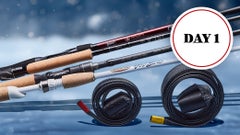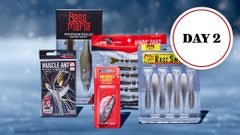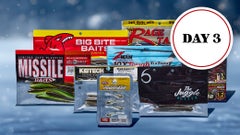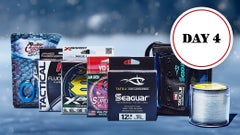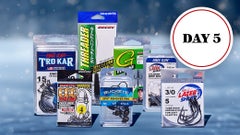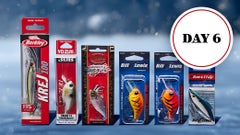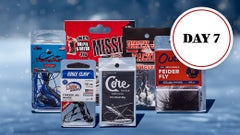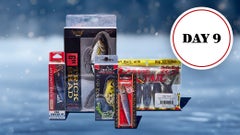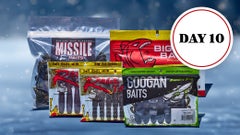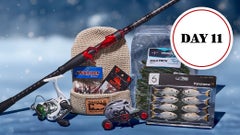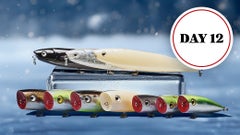FLW Kentucky Lake Baits, Gear & Patterns
Dave Lefebre's Winning Pattern, Baits & Gear
There was plenty of size there this year and he mined it for all it was worth in winning with a closing weight of 77-03. He caught more than half of his weight (43-04) on the weekend and his 6 1/2-pound winning margin was the largest margin of victory in a Tour Major since last year’s Kentucky Lake event. The win was his first tournament triumph since the 2009 Toyota Texas Bass Classic and second career FLW Tour Major victory.
The area Lefebre had found a few years ago was something most anglers would overlook with their electronics. A staunch opponent of the umbrella rig in competition, he wasn’t about to join the masses chasing schools of offshore fish and not knowing if he’d be able to get on them. “That area has a lot of potential when you look at the map,” he said. “It has a lot of little ditches and subtleties. I had a practice partner with me and I told him we were going to this flat and that it had potential in the past. I just wanted to fish it because I felt like there was something around there.
“We hit that spot for 90 minutes or 2 hours. All week in practice, I didn’t want to fish all the obvious stuff on the map that everyone was fishing. I’d go over that stuff and then idle around off of it looking for things that were off of the structure -- little things.” He didn’t anything over 3 pounds in practice, but had a hunch this area and others like it could hold the key to a tournament where conditions were drastically different than a year ago. He combed the shallows with Rapala DT-6 and DT-10 crankbaits and was able to get a better picture of how things laid out under the boat. “These spots that I was fishing you can’t really find them on your graphs or StructureScan,” he said. “It’s stuff you just have to fish and cover a lot of water. Then when you get a bite, you throw a buoy out and maybe there’s something to it or maybe it’s a fluke. You don’t know until you get that first bites. “I didn’t have any idea what was there until the 2nd day when I caught 19 pounds.”
Competition:
Lefebre laid a solid foundation for the week on day 1, weighing almost 15 pounds off a jig with a double-tail trailer, which had him in 40th place. On day 2, he happened upon a shad spawn on his best area in the morning and filled his livewell pretty quick on a swimbait. He wound up with 19-00 and moved up to 9th heading into the weekend. “They didn’t do it the first day,” he said of the shad. “There weren’t any flickering around. I didn’t feel them bumping my swimbait. The second day, I went there and the shad were flickering around and it was on, and I caught them quick.” The shad were spawning again early on day 3 and he had a magical early-morning stretch that saw him box 18 pounds in roughly 13 minutes. He then upgraded three times the rest of the day and wound up with a tournament-best 23-15 to pull into 2nd place, just 2 ounces out of the lead.
“It’s the first day I can remember eating and drinking normally,” he said on stage. “I was able to relax." “When the shad were spawning, it didn’t matter how I presented the bait," he added later. "I had to make the exact cast because the spot was as big as my front deck, but boat position didn’t matter.” Late on day 3, he toyed around with boat position and honed in on the right cast, which helped him keep his baits in the strike zone longer. “It was very obvious because I’d gone an hour without a bite and then moved, and then it was on,” he noted. He left his fish biting each of the first 3 days and then hammered away on the final day. While he was focused on a shallow-water area, he wasn’t shielded at all from the winds that peppered the lake on the weekend. In fact, the gusts took away his ability to make the cast he needed to the morning of day 4. “I couldn’t feel what I needed to feel,” he said. “I feel like I knew every shell down there and once I’d hit those specific, little shells and the bait started wobbling, I knew I’d get a bite. That’s how specific it was.”
He returned to his primary area once the wind relented in the early afternoon and he was able to target the fish the way he wanted to. Soon after, he caught a 6-pounder that sealed the win. “I was able to make that cast and feel what I felt the day before and then boom,” he said. “If the wind hadn’t died down in the afternoon, I might not have caught that big one.”
Winning Pattern:
When fishing his primary area and once he figured out how to reach the sweet spots, he backed off and worked on it from a distance. “I was staying way off of it and I was throwing it out there as far as I could,” he said. “As soon as the bait hit the bottom, I’d start cranking it and most of the bites were within the first 10 or 20 feet.”
Winning Gear:
Jig gear: 7’8” heavy-action Dobyns Champion Extreme Mike Long Signature Series jig rod, Shimano Chronarch casting reel (7.0:1 ratio), unnamed 14-pound fluorocarbon line, 3/4- and 1-ounce Tabu Tackle Open Water Series jig (green pumpkin), Living Rubber skirt (brown), 5” Yamamoto Pro Double Tail grub (green pumpkin). He added purple tinsel to a brown Living Rubber skirt for the jig.
Swimbait gear: 7’9” heavy-action Dobyns prototype casting rod, same reel, unnamed 20-pound fluorocarbon line, 1/2-ounce jighead, 5 1/2” Storm WildEye Pro Paddle Tail swimbait (glass minnow). He super-glued the jig head to the nose of the swimbait to give it a bigger profile. On days 1-3, he showed the fish nothing but the Storm Paddle Tail, but mixed in other unnamed swimbaits on day 4. In practice, he scoured the flat with Rapala DT-6 and DT-10 crankbaits (pearl gray shiner) using an 8’ medium-heavy Dobyns Champion Series crankbait rod. “It’s not what I ended up catching them on in the tournament, but it was just as important as the swimbait or the spot because it helped me cover a lot of water really fast and find those tiny sweet spots.”
Main factor: “There are so many. Finding those spots that were getting zeo pressure and putting the motor down and just fishing and covering a lot of water with those Rapala crankbaits. Without a doubt, that was the key.”
Performance edge: “StructureScan was extremely important. I used the DownScan and SideScan at the same time. You can’t fish a lake like this without it. You just can’t compete without it.”
Chris Baumgardner's Pattern, Baits & Gear
However, on the final morning he was kindly asked to leave his best area by the owner of the marina and he obliged, but not before he’d caught 11 pounds. He couldn’t connect on any significant upgrades the rest of the day, however. “I really slowed down after day 1,” he said. “The fish were on the ends of the docks instead on back in them. The sun was key for me, too, because the big ones seemed to right on the shade line.” He also flipped a jig along a stretch of shallow rock and docks on Kentucky Lake that produced a couple key fish on day 1 and a 3-pounder in the final hour of day 4. “That saved it saved me that first day,” he added. “I caught a 4 and 3 in the last hour doing that.”
ChatterBait gear: 7’3” medium-heavy Duckett Fishing Micro Magic casting rod, unnamed casting reel (6.4:1 ratio), 17-pound P-Line fluorocarbon line, 1/2-oz. Z-Man ChatterBait (shad/blue glimmer), Zoom Super Fluke trailer (glimmer blue). He caught his biggest fish on days 1 and 4 on a 1/2-ounce Shooter jig (brown) with a Zoom Big Salty Chunk trailer (green pumpkin).
Main factor: “Just forgetting about the deep stuff and committing to fishing shallow. I got it in my mind that I’d fish shallow and I’ve done that for a lot of years. When fishing marinas this time of year, you’ll get a lot of the shad fry and there’s a lot of activity around there. They do it around this time of year for about a month.”
Performance edge: “I’d have to say the ChatterBait. My presentation was the key because as I got to fishing it, I’d throw it out and swim it and then let it fall. That seemed to trigger the bites and seemed to be the key to catching the bigger fish.”
Kyle Mabrey's Pattern, Baits & Gear
“Getting to go to a Tennessee River tournament, I wait all year for these events,” he said. “It’s such a unique fishery. Kentucky Lake is just awesome. The key was locating schools of fish, but it wasn’t about locating massive schools for me because everyone else seemed to have found those. “The places I had the most confidence in were places that held like 10 to 25 fish. It wasn’t massive stuff, but that’s what I chose to target.” One of his prime areas was a gravel bar in 12 feet of water that had some isolated stumps on it. It was adjacent to a ditch that dumped into a creek channel and dropped from 14 feet out to 22 or 24. “Every day, the fish were located in a different area of the bar,” he said.
Umbrella rig gear: 7’7” medium-heavy Powell Endurance Series casting rod, Shimano Chronarch casting reel (6.3:1 ratio), 65-pound Diamond braided line, unweighted 3-wire Yellow Hammer umbrella rig, 3/4-ounce Buckeye J-Will swimbaits jigs, unnamed 6” hollow-body swimbaits (various shad patterns). Since he was fishing Tennessee waters, he had to use a 3-wire rig. He caught them under sunny conditions and cloud cover, but he threw a version of the rig with willow blades that produced better under cloud cover. He used a fast retrieve with the umbrella rig. “Speed was a key. I wasn’t just crawling it. I had to move it fast,” he said. He used a 7'6" medium-heavy Powell casting rod to land a 6-pounder on a single swimbait rigged on a 3/4-ounce Buckeye J-Will jig. He also caught a couple upgrades on a Zoom Magnum Ol’ Monster worm and had another fall for a flutter spoon.
Main factor: “Not selling out and committing to one thing. The key was being versatile with your lures. Different lures triggered big bites in difference conditions.”
Performance edge: “Trusting in my (Hummindbird) electronics and trusting what I saw. I’ve spent a lot of time tweaking them and learning them and it’s paid off in my last few Tennessee River offshore events. Usually out here, you’re looking more for stucture or bait fish, but right now you’re looking for structure and schools of fish. There’s a way it looks when they’re bass and and way it looks when they’re suspended bass and also when they’re actively feeding catchable bass.”
Jim Moynagh's Pattern, Baits & Gear
He combed those ledges with his a big jig and double tail grub trailer, catching 19 of his 20 weigh fish on that combo. However, a shortage of spots that held quality bites undermined his quest for victory. He started strong, weighing more than 40 pounds through the first 2 days, but managed just shy of 27 through the weekend. He simply ran out of fish. “I had a lot of schools I didn’t fish,” he said. “They were so far away I just didn’t get to them. On days 1 and 2, I had good bags and I didn’t want to run south and risk killing the fish I had so I just stayed on the northern end. On day 3, I couldn’t really run because of the wind and on day 4, I fished up north again, but the wind came up again. I tried a couple spots, but I never got as far as Paris.”
Jig gear: 7’ heavy-action unnamed graphite casting rod, unnamed casting reels (7:1 and 6.2:1 ratios), 12-pound unnamed fluorocarbon line, 3/4-ounce All-Terrain Tackle Jim Moynagh’s Football Head Jig (Moynagh’s Magic/green pumpkin/purple), unnamed double-tail grub trailer (green pumpkin). He also threw a prototype 1-ounce version of the jig when the wind picked up. He caught one weigh fish on a Carolina-rigged soft plastic jerkbait.
Main factor: “Just fishing my strengths instead of trying to learn the (umbrella) rig or getting cute and fancy. I’ve done well fishing structure with a jig. It sounds simple, but it was a lot of work.”
Performance edge: “Success in fishing is the accumulation of so many minute details that make the difference. One thing that was nice thing to have on the rough water was a long-shaft trolling motor. It just keeps the prop in the water longer when the waves pick up.”
Jay Yelas' Pattern, Baits & Gear
“What I did last year worked so well, that’s why I fished Barkley,” he said. “Nobody fishes there in our tournament and there was a huge section of lake just full of bass that no one was fishing but me. My success last year drew me back there this year.” He spent his entire practice session in Barkley, which he calls “the forgotten lake,” and had enough spots pinpointed where he could catch a good one that he couldn’t have fished them all in a day. “All of the spots were oriented to the main river,” he said. “I caught a lot of fish off laydowns or logs. The topwater worked well on points and so did the shaky-head worm. I also fished some docks and brush piles. “I wish in every tournament I could have a 10-mile stretch all to myself. If you ever can find that, you’ll always do well. That’s how it’s been in my career.”
Jig gear: 7’6” medium-heavy Abu Garcia Veritas flipping rod, Abu Garcia Revo STX casting reel (6.4:1 ratio), 25-pound Berkley Trilene XT line, 5/8-oz. Berkley Jay’s Flippin’ Jig (green pumpkin), Berkley PowerBait Chigger Craw trailer (green pumpkin). He also threw the same jig and trailer in a black/blue pairing. He opted to use monofilament when making short pitches because of the dirty water. He hadn’t used mono since last year’s Kentucky Lake event. He caught five of his weigh fish on a Heddon Super Spook topwater plug. Four of his weigh fish came on a 6 1/4” Berkley Havoc Bottom Hopper (green pumpkin) rigged on a shaky head using 10-pound Berkley Trilene 100% Fluorocarbon line.
Main factor: “Having confidence in fishing shallow in the summer there and sticking with it. It’s so easy to vasilate between shallow and deep with so many fish out deep. I never fished deeper than 5 feet the whole week.”
Performance edge: “My Typhoon sunglasses were crucial. I thought they played a big role in picking out pieces of submerged wood that couldn’t really see, but you could make out a dark shadown. My (MinnKota) Talons were huge, too. Fishing shallow like I was and in the wind, they are so valuable when fishing shallow water. I don’t know how we did it before we had those.”
Kentucky Lake FLW Tour Winning Pattern Bassfan 6/12/12 (Todd Ceisner)
Kentucky Lake Patterns 2-5 Bassfan 6/14/12 (Todd Ceisner)



















